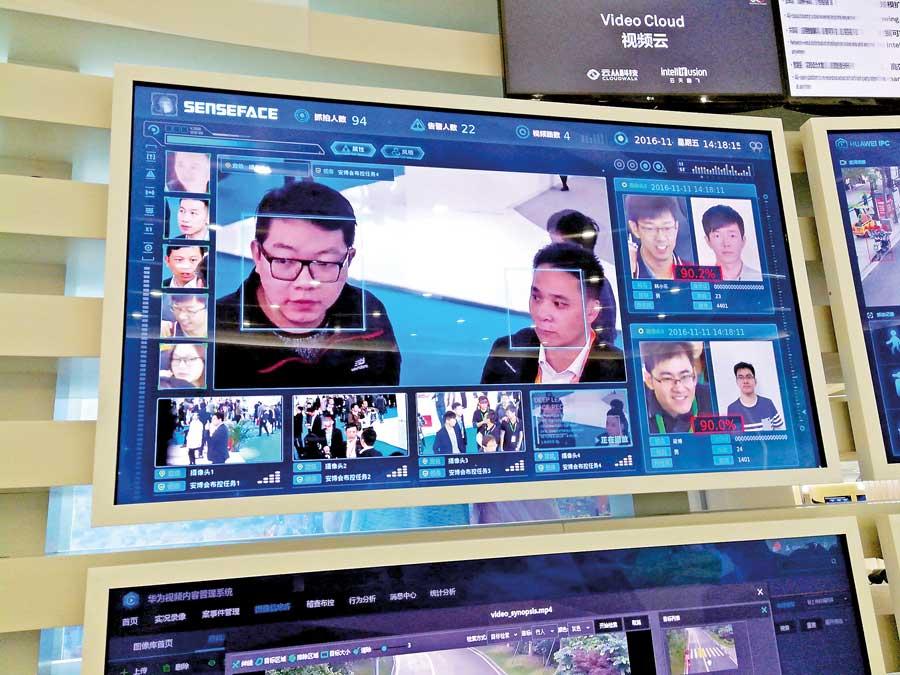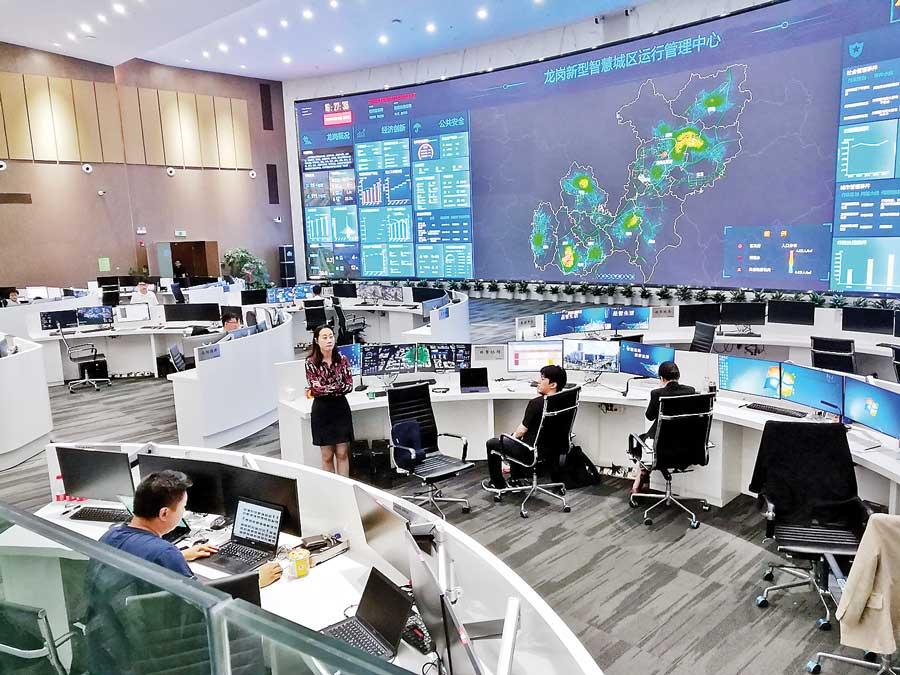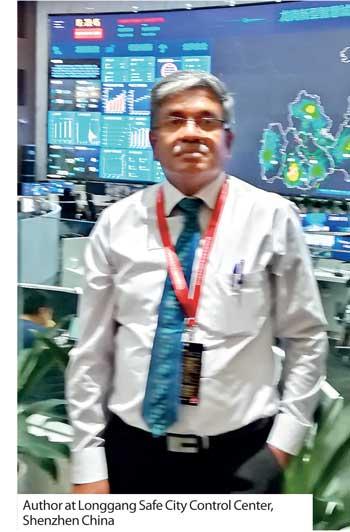28 May 2019 - {{hitsCtrl.values.hits}}

How video surveillance is done at Longgang Safe City Control Center, Shenzhen China
 A photo showing a ‘cop’ checking the sack of ‘terrorist suspect’ for ‘explosives’ went viral over past weeks. The ‘cop’ was a boy of about 17 years old in his all white school uniform, conspicuously displaying the badge of a prefect.
A photo showing a ‘cop’ checking the sack of ‘terrorist suspect’ for ‘explosives’ went viral over past weeks. The ‘cop’ was a boy of about 17 years old in his all white school uniform, conspicuously displaying the badge of a prefect.
The ‘terrorist suspect’ was another boy in school kit, few years younger. And no matter how many such ‘terrorist suspects’ the ‘cop’ might have checked he would find no ‘explosives’, but only textbooks, pencils and lunch boxes. We all know ten-year olds do not bring HMX to schools in their backpacks. We also know 17 year olds are not trained to detect explosives, and if at all were there explosives in a school bag, he would have been the first victim.
Still we all continue this stupid exercise at school gates. It is our only thinkable reaction to what has been termed the world’s worst co-ordinated bomb attack; in terms of casualties the second worst terrorist attack just next to 9/11. Checking school bags gives us some false comfort. In reality, we are as naked as ever.
This isn’t a first. If we were to turn the clock back beyond the proverbial short term memory of two weeks, you might remember feeling naked and helpless multiple times earlier. Let’s take one by one.
December 26, 2004. Sri Lanka faces its worst-ever natural disaster recorded in recent history. The Boxing Day tsunami is nothing short of harsh reality hitting one’s head like an express train. Nearly 40,000 people die in the span of a few hours. More than a million, out of the total Sri Lankan population of about 20 million, are displaced. The aggregate cost to property is later estimated to be nearly two billion dollars.
Not that we didn’t know it coming. Not that we couldn’t have avoided it. Few minutes after 7.00 am local time tremors of a large earthquake occurs in the Indian Ocean, near Sumatra, Indonesia were felt in some parts in Sri Lanka. These were recorded at the Pallekele Seismological Station, where sophisticated equipment monitors such events round-the-clock. Did anyone notice? No. At 7:07 a.m., the resulting seismic signals make the Hawaii-based Pacific Tsunami Warning Center (PTWC) trigger an internal alarm that alerts watch standers located in different regions. At 7:14 a.m. local time, the PTWC issues a bulletin providing information on the earthquake and a possible tsunami in Indian Ocean. At 8:04 am, the PTWC issues bulletin No. 2, revising the earthquake magnitude to 8.5. We learned these days later. The fact: This warning comes 23 minutes before the first waves would eventually strike the east coast of Sri Lanka. Were there an island-wide radio broadcast of the warning, time could have well been sufficient for local communities to vacate the risky areas. We pay the supreme price of not having right systems and technology.
Fast forward ten years. October 2014. A landslide occurs at Meeriyabedda, Koslanda. In 2012, the Landslide Research and Risk Management Division of NBRO had identified 47 critical sites with landslide possibilities. It also has recognised 30 schools under threat in Badulla, Nuwara Eliya, Kandy and Matale districts. Out of the identified 47 landslide sites, NBRO had prioritized 16 sites for urgent mitigation action. In 2013, four sites out of them have been supported by JICA for mitigation. Meeriyabedda apparently has not drawn adequate attention of NBRO. The disaster strikes unannounced.

Others react to disasters with new advanced solutions; we don’t
On all above occasions, it was apparent we paid the supreme price of not having an effective strategy, an efficient system or an advanced technology. We were fighting both natural and man-made disasters with primitive means. We realize this only in aftermath of a disaster.
Our leaders promise doing all what is possible to avoid repetition. Either they shamelessly lie or have absolutely no idea what to do. Systems have hardly been improved following any of these incidents. No technologies have been introduced. No new systems were adopted. After few useless measures just to give public a temporary comfort, things come back to normal. We are all naked as ever.
It wasn’t like that at international level. Why we didn’t see a repetition of 9/11 for nearly two decades now is, because all possible technical measures were taken to avoid a similar incident. Already, many international airports have been equipped with Explosives Trace Detection Devices to scrutinize passengers’ hands and luggage for explosives residue. (The writer has been subjected to such a test in 2014 at Canberra Airport and had to undergo a series of tests as the first one gave a false positive).
Advanced scanners allow security personnel to look under passengers’ clothing for concealed weapons or explosives. (After complaints on privacy concerns the upgraded software now only shows a vague contour of the body.) Onboard surveillance systems, including sensors and video cameras in the cabin, as envisioned by the European Commission’s Security of Aircraft in the Future European Environment project are in the pipeline. They may also include sophisticated software that would analyze passengers’ facial expressions and movements for suspicious behavior.

All cargo entering the United States overland is now scanned for radiation, whether it comes from sea or air. Almost all developed countries have introduced biometric identification for visitors. After 9/11, changes were also made to the security of cockpits making hijackings more difficult.
According to the US Federal Aviation Administration, doors should typically be tough enough to withstand a grenade blast and are usually left locked from inside throughout the flight. These are the rational responses.
Sri Lanka, on the other hand, has blindly returned to pre-2009 informal and rudimentary security measures. Checking bags and parcels at building entrances commenced in mid 1980s. This followed LTTE doing several remote explosions in the form of parcels left at public places. LTTE itself has given up this primitive strategy.
By early 2000s they have moved towards more advanced and effective ones. We, having nothing else to do, have commenced as it would be the panacea for all woes. It would have made no difference. The only reason why we didn’t witness a repetition could be that terrorists didn’t aspire any.
Safe cities and video clouds
If the threat is real and international it is high time we seriously consider the introduction of a ‘safe city’ solution in the form of intelligent and comprehensive video cloud.
‘Smart City’ and ‘Safe City’ are two tech buzzwords widely used in administrative circles for some time now. Concept of Smart City is relatively well known. ‘Smart City’ refers to an urban area using Information and Communication Technologies (ICT) to develop the quality of urban services with or without reducing their costs.
This includes data collected from citizens, mechanical devices, assets, processed and analyzed to monitor and manage traffic and transport systems, power plants, water supply networks, waste management, systems information centers, schools, libraries and hospitals. Smart City technology allows city officials to interact directly with community and urban infrastructure and monitor the city and its evolution.
The functions of smart cities are developed to manage urban flows and enable real-time responses. A smart city is therefore more prepared to respond to challenges than a city that only has a transactional relationship with its citizens.
So what is a ‘safe city’? A basic definition could be a place proactively reduce urban crime such as antisocial behavior, street robbery and burglaries through a mixture of policing, technology deployment and offender management. However, as one expert put is it can be seen as cities of the future deploying a holistic approach to metropolitan security.
Cities that collect data (big data) from transport systems, sporting events, emergency services, hospitals, traffic management systems, private and public sector security systems – to name a few – and through data mining techniques, trend analysis and 3D visualisation, can improve services and, more importantly, predict when increased services are required.
Case studies can be brought from North America to Europe, but for proximity reasons an Asian city would be more appropriate. Consider this from Manila, Philippines.
Transformation of Bonifacio, part of a former Philippine Army base near Manila, into a world-class business and residential center commenced about a decade back. The idea was to develop that as Manila’s ‘crown jewel’ and a model for other cities. City security has been a key concern from the beginning. That called for a comprehensive video surveillance solution.
Not that it wasn’t there. Like in any other city of today thousands of CCTV cameras were watching city activities. Still they were primarily of low-definition analog cameras that did not meet safety requirements. Low-resolution surveillance footage lacked the kind of detail needed by law enforcement authorities to carry out successful investigations. For instance, car license plates were unreadable.
Manual conversion of all videos from analog to digital, coupled with serious storage constraints, meant that the videos could not be kept for long after conversion. Add to that, decentralized camera surveillance made it difficult to analyze footage. Poor legacy network infrastructure included limited, but expensive, fiber networks for transferring images. All these issues severely hampered law enforcement and crime prevention efforts.
Upgrade in city called for critical changes in public security solution. This was to come in the form of a new, high-definition surveillance solution connected and centrally managed. Monitoring points needed to be evenly distributed to ensure comprehensive coverage of the city.
Finally, these images must be transmitted across varying distances, unblocked by high-rise buildings. High-Definition (HD) Intelligent IP Cameras strategically located guaranteed comprehensive coverage. Network was designed as a Wi-Fi backhaul in such a way to ensure images could be transmitted across varying distances to the command center without being blocked by structures. Personnel at the command center use video analytics to coordinate camera visuals. Similar projects are underway in many other Asian cities.
Centralised and intelligent video surveillance become extremely useful in the wake of advancements of facial recognition technology, which has seen nearly a 20 fold improvement following 9/11. A major advantage of a facial recognition system is the ability of mass identification as it does not necessitate the cooperation of the test subjects. Systems installed in airports, multiplexes, and other public places can identify individuals among the crowd, without passers-by even being aware of the system.
The US Department of State operates perhaps the largest face recognition systems in the world with a database of about 120 million American adults, with photos from driver’s license photos. As of 2017, China has deployed facial recognition technology in multiple cities. Surveillance cameras are now a common sight every hundred meters or so in several cities, as well as facial recognition checkpoints at public areas like gas stations, shopping centers, and mosque entrances.
Beating bad guys in social media game
A process somewhat parallel must happen in virtual world, as today it represents a similar space. What we do in physical world takes place there too with one to one correlation. Individuals meet each other, introduce themselves to others, discuss politics, agree and disagree, check for similar thinking, pass information and disinformation and build networks. These individuals may contribute either for construction or destruction of social structures.
Challenge is to block destructive efforts while allowing normal encounters. Typically all social media platforms use their own means for this. The process includes, inter alia, close scrutiny by bots (automatic or semi-automatic software agents that interacts with computer servers), analysing reporting patterns by other users, removing any praise, support or representation of an event designated as a ‘terrorist attack’ for violating common community standards; close monitoring of situation to enforce against any hate speech or any action to coordinate harm towards people of any one religion, ethnicity or sensitive characteristic, removing images and/or videos containing extremely graphic imagery of dismembered bodies from an attack, in accordance with our graphic violence policies and controlling misinformation on the platform. These are great during normal times.
What happens in certain turbulent circumstances is multi-fold increase in generation of these undesirable activities. Then they could not be managed within the normal process of social media platforms only. Authorities in a country like Sri Lanka have no other option than bluntly blocking selected social media platforms. We can agree or disagree on the periods of blocking, but the act is essential – at least now.
Nobody says blocking social media is meritorious. Such an extreme move disrupts perfectly normal conversations; seriously affect many businesses that primarily depend on social media; reduces whatever the limited data traffic we have and makes telecom companies worry about their top and bottom lines. We have seen a typical drop of 35 - 40 percent traffic just with a block of Facebook. Still, this is a measure to be taken, in the absence of any better way, to prevent a worse evil. While social media activists are eager to fight for total freedom we do have evidence at least on two occasions, once in Mawanella and more recently at Minuwangoda on social media inflicted violence.
The experience is not just local. Indonesia, the country with third largest Facebook user community (120 million users) partially blocked it few weeks back to prevent the spread of fake news after violence broke out in Jakarta following the announcement of official election results. Jacinda Ardern, Prime Minister New Zealand has been an ardent critic on the behavior of social media platforms ever since Christchurch mosque attacks that killed over 50. (The shooting was streamed live on You Tube while Facebook and Twitter have been used proliferating the same) Her stance: “We all need to act, and that includes social media providers taking more responsibility for the content that is on their platforms.” Her problem is New Zealand is a market too small and some social media players might leave altogether instead opting for regulation. France - a much bigger market, on the other hand, has already taken action on its own. France has already placed regulators at Facebook for the first six months of 2019 to determine whether its processes for removing hate-fueled content could be improved.
Sri Lanka too faces the ‘small market problem’. Ad hoc and prolonged blocks, as well as regulations too strict, might make social media firms leave the country out rather than comply. We need to take such issues at regional level. There should be a common stance all SAARC countries can take. India is the largest market for many international social media platforms, with China has their locally brewed ones, so we would be in a better position to influence the decisions.
Conclusion: Yes, we have resources, but…
We spend Rs. 400 billion for defence. That was the allocation for the Ministry of defence for 2019. It is also 2.5 percent of countries GDP and nearly Rs. 20,000 for a person. (In comparison government spends only Rs. 9,000 for the healthcare of an individual.) This is sizable.
In circumstances that battle against terrorist moves from ground to virtual space, we should be able to divert adequate funds for right technical solutions. It is an essential step given the complexity of the confrontation today. Advanced solutions are expensive but still within the range we spend for less necessary projects. If we really desire bringing down the costs, the best is to join a super power who shares similar concerns.
What we lack is not funds for sure, but political and administrative will at top level. Key decision makers of the country are relatively too old to be favourable towards technology.
Rather they see it a black box with a monster inside. The vast rural majority that constitute their vote banks see investments on technology pure waste. Security, still, is a less concern. Then, unlike an overhead pass, the voters don’t directly see the results of an advance technology solution. The cause and effect relationship is not too visible. Still high-tech based security systems is a public good and there is no other way achieving that with government out the equation.
(Chanuka Wattegama, and academic and a policy researcher can be reached at [email protected])
24 Nov 2024 1 hours ago
24 Nov 2024 2 hours ago
23 Nov 2024 23 Nov 2024
23 Nov 2024 23 Nov 2024
23 Nov 2024 23 Nov 2024